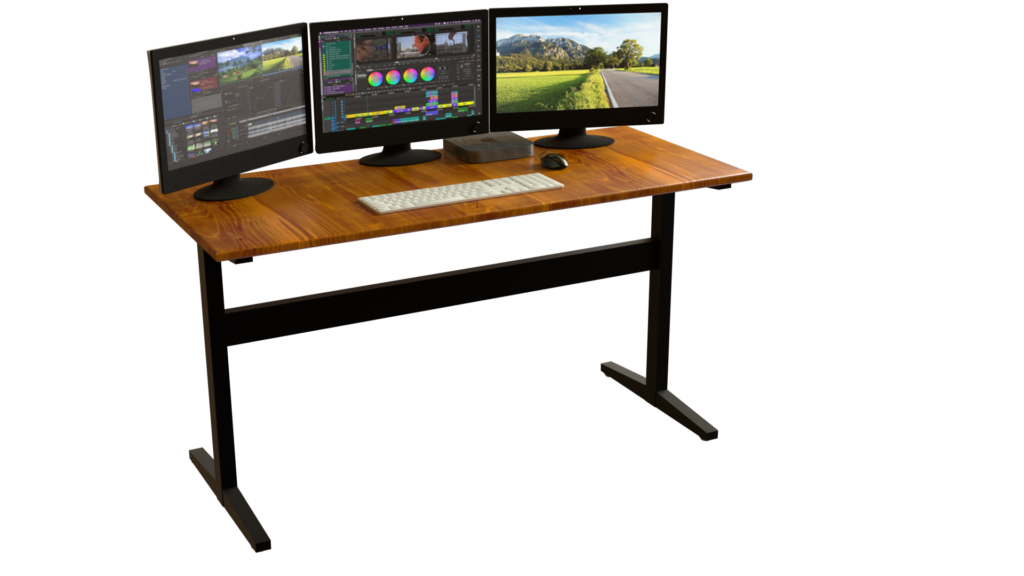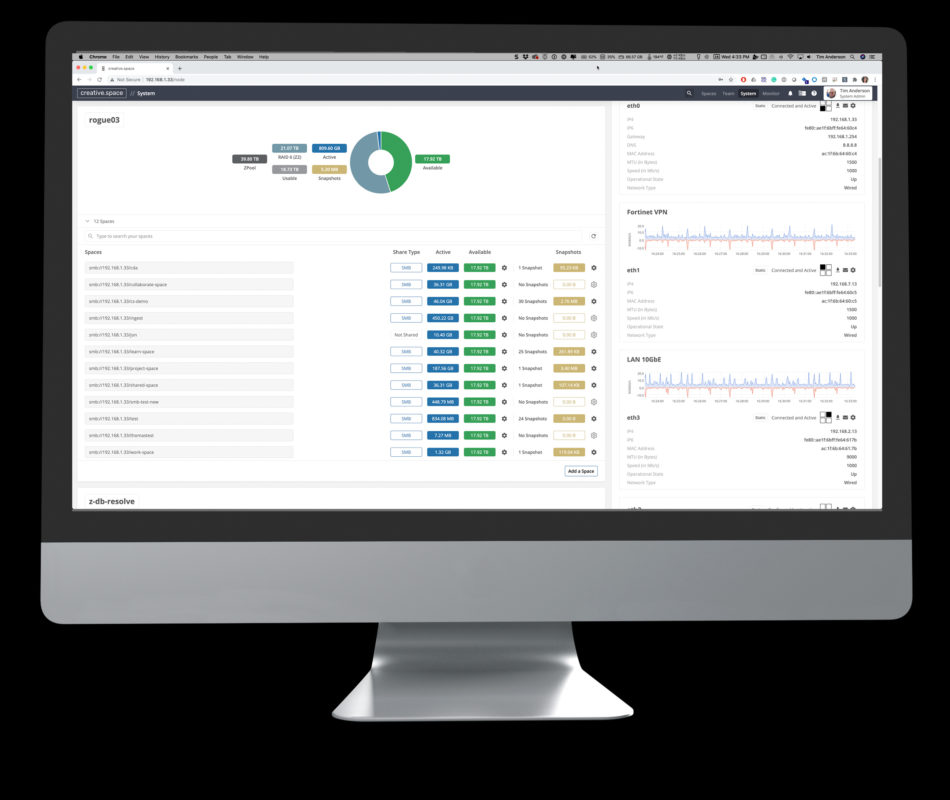
Here’s the question though: is there a way to hedge your bets? Can you invest in a hardware solution that delivers remote workflows to your home studio here and now, but allows you an inexpensive onramp back to an on-premises studio work environment when it’s time to do so?
DigitalGlue offers such a solution with their creative.space platform. We’ve covered this company in the past, but what’s most compelling here is that their storage-as-a-service model means that whatever solution you choose for a home studio can be migrated back to an office environment without a hit to your pocketbook. And with the announcement of the //ROGUE PRO, that solution just became even more attractive for boutique studios.
Let’s take a look at the creative.space solution to remote workflows, both from a hardware and software standpoint.
Working from home while your data stays at work

When users need local access to files, the built-in FTP server enables peer-to-peer transfers, cutting time to delivery in half by eliminating the middle-man. Now FTP security gets a bad rap—and for good reason. Good ol’ fashioned FTP is inherently insecure and I’m always amazed when people ask me to download proprietary files from their unsecured FTP server. Fortunately, creative.space protects the FTP transfers by using a 256-bit encrypted ZeroTier VPN. An additional benefit of the VPN is that all of the management features available as part of the creative.space software can also be accessed remotely. In fact, the remote security access to the on-prem data works off the same simplified user management and permissions system at the heart of the server software. This LDAP integration provides users complete access to all the data on the storage where it is, without having to copy or move it to a dedicated directory like with other solutions.
Even with peer-to-peer transfers, managing separate instances of the same project directory across storage devices is a big headache and one that the DigitalGlue team has worked with customers to address. Instead of simply “transferring” via FTP, directories can be synced manually or on an automated schedule. One of their customers, with only residential internet in LA (~25 Mbps), was able to transfer 1.1 TB of data overnight (12 hours). If data needs to be moved faster, creative.space supports the transfer of data via sneakernet (the physical transport of drives from one location to another) in addition to secure FTP transfer. Either way the source and destination locations are compared to identify exactly what files need to be transfered, relative to the shared root folder for the project, avoiding orphaning of versions or duplication of media. Once the initial dump of media is complete, nightly synchronization downloads and uploads keep everything in sync.
Now there are services like Signiant that dramatically accelerate data transfer speeds for digital media. At the end of the day, however, terabytes of data are still terabytes of data. Even on a gigabit internet connection (which will probably run sustained at around 850 Mbps) it will take a day and a half to transfer 10 TB. That’s assuming solid connections, no significant dropouts, and that you actually have a sustained synchronous gigabit connection. For large, 4K projects FTP alone would be impractical.
That’s where the hybrid FTP/sneakernet approach makes sense. Unlike the traditional methods of just dumping data on a drive however, in the creative.space workflow the data gets synced to the office server once it arrives at the editor’s home. No orphaned media, no duplicate data. From there the VPN-secure FTP transfer can keep everything in sync. You have the freedom to use the best strategy for each situation with a solution that costs the same no matter how much data you are moving.
Working from home without waiting for your data to leave the office
“That all sounds great,” you say. “But I’m an important editor and I need to get to work as soon as the media is ready at the office.” creative.space has you covered there too. They offer remote access to streaming proxy footage, meaning you can start working immediately. When you take a break or hit the hay for the night, the full-resolution files can download (or be “sneakernetted” to the suburbs by an unfortunate, underpaid PA), ready to replace the proxies in your timeline.
The core of this workflow is a two-pronged approach: 1) Render from where the data is and 2) Provide instant remote access via proxies. Final Cut Pro X, Adobe Premiere Pro, and now (with the release of version 17) DaVinci Resolve all support linking proxies to your clips that can be used for playback instead of the actual clips. Rather than waiting for files to download, users can actually mount shared Spaces over the internet for real-time remote editing. The “Fog” strategy focuses on getting users instant access to proxies and then syncing the larger files overnight for users to start working with the next day.
Working from home when your data needs to be local and fast
OK, so what if none of those solutions work for you? Maybe your workflow is too unique, or your work habits are just too disorganized (you’re a creative after all) to be making trips to the office every time you need to ingest RAW 4K files. You need full access to the server at local speeds. How do you pull that off without spending a fortune on servers that your family has to squeeze past to get to the bathroom?
That’s where the creative.space //ROGUE line comes in. Unlike the cloud, with creative.space the hardware can be at a location of your choosing with high-bandwidth access for local users and remote access only limited by internet speeds. Starting with the original “owned” //ROGUE (from $4,795 with 48TB of storage and a year of managed service), even boutique productions with a humble budget can benefit from managed storage. The //ROGUE is a small form factor “desktop” server with 10Gbit connectivity that has more than enough horsepower to drive multiple 4K streams to your edit station. And when the COVID all-clear siren blasts, you can pick it up and take it to your offices ready for a team of three or four editors to access together.
The //ROGUE has all the same software functionality of its bigger brothers in the creative.space line-up. That means if your home has a decent internet connection, you can provide a freelancer or employee with the same remote access workflow I described above, in this case from the server hosted at your home.
If you really need to move data quickly, the newly announced //ROGUE PRO offers some pretty impressive specs. Unlike the original //ROGUE, the //ROGUE PRO is only offered as a support contract (you don’t own the box like you do the //ROGUE), but that also means you can upgrade capacity and performance at any time as your media requirements grow.
We’ll be putting a review unit through its paces soon, but for now let’s take a look at what it offers. A 12 core Ryzen 3.8 GHz processor means the unit can push a lot of data simultaneously around the system. Of course, the memory matches the performance of the CPU: up to 128MB of 3200 MHz ECC RAM.
There are other impressive specs (multiple NVMe and M.2 configuration options for fast cache performance), but the one that surprised me a little? The inclusion of 3000 Mbps WiFi 6. The folks at creative.space tell me that in their initial testing they’ve been able to reliably edit high bandwidth footage across that WiFi 6 connection. That opens up a whole realm of networking possibilities for creatives whose landlords don’t want them drilling Cat6 tunnels through their heritage-protected stonework.
I know for a lot of people that even $595 a month sounds like a chunk of change. In that case you may prefer to own your own system (the original //ROGUE). But when you consider the various security and hardware amortization benefits, it’s a price that will make sense to a lot of smaller companies with a reliable stream of work flowing through their servers every month. The //ROGUE PRO fills a nice space between the original //ROGUE unit and it’s bigger brother the //AUTEUR (which starts at a monthly service contract of $995).
Be sure to check out our hand-on review of the //ROGUE PRO in the coming weeks.

